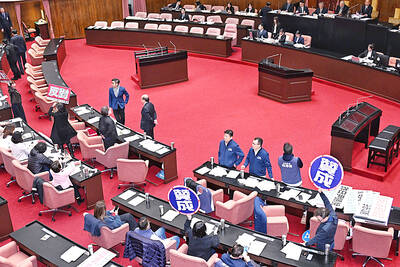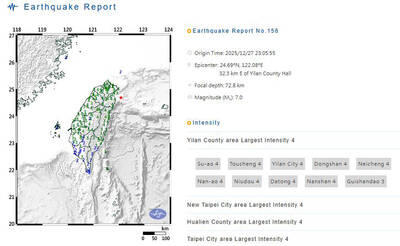The Ministry of Economic Affairs (MOEA) yesterday said that chips from Taiwanese semiconductor companies were not making their way into Chinese missiles “to the best of our knowledge.”
A report in yesterday’s Washington Post alleged that a Chinese company named Phytium Technology Co (飛騰) used chips made by Taiwan Semiconductor Manufacturing Co (TSMC, 台積電), along with US software, in advanced Chinese military systems.
“TSMC has long placed strict controls on their chips. The export of high-tech products from Taiwan is also highly regulated,” Minister of Economic Affairs Wang Mei-hua (王美花) said.

Photo: Zha Chunming / Xinhua via AP
“According to our understanding, none of the end uses for those products was military,” she added.
“To the best of our knowledge, TSMC’s exports not only meet Taiwanese standards, they also comply with applicable US regulations,” Wang said. “If information emerges that shows differently, we will of course investigate.”
Given the high volume of chip exports from Taiwan, the Bureau of Foreign Trade would educate exporters more to ensure that Taiwanese and international regulations are being followed, Wang said.
“TSMC has a rigorous export control system in place, including a robust assessment and review process on shipments to specific entities that are subject to export control restrictions,” the chipmaker said in an e-mailed response to the report.
“Moreover, TSMC has put in place processes to help identify abnormal circumstances in a transaction with due-diligence follow-up. With these processes already in place, we are not aware of a product manufactured by TSMC that was destined for military end-use, as alleged in the coverage,” it said.
The Washington Post article cites Ou Si-fu (歐錫富), a research fellow at the Institute for National Defense and Security Research (國防安全研究院), as well as an anonymous analyst.
Ou told the Taipei Times by telephone that he cannot speak specifically in regards to Phytium, but that the use of Taiwanese chips in Chinese military equipment would be “hard to trace.”
“The problem is that the chips are dual-use technology. They can be bought off the shelf for one application and then used in military equipment that is aimed right back at Taiwan,” Ou said.
Current Taiwanese and US safeguards for preventing Taiwanese chips from ending up in Chinese munitions are inadequate, Ou said, adding that meaningful measures for tightening up the flow of chips to China must come from the US.
“The US is ultimately in control of the upstream technology and equipment for the chips, even though Taiwan is the manufacturer,” Ou said. “They must be the ones to crack down.”
When asked whether Taiwanese can simply choose not to sell advanced chips to China, Ou said that it was unlikely.
“It would be asking them to voluntarily make less money and offend the Chinese at the same time,” Ou said.

A car bomb killed a senior Russian general in southern Moscow yesterday morning, the latest high-profile army figure to be blown up in a blast that came just hours after Russian and Ukrainian delegates held separate talks in Miami on a plan to end the war. Kyiv has not commented on the incident, but Russian investigators said they were probing whether the blast was “linked” to “Ukrainian special forces.” The attack was similar to other assassinations of generals and pro-war figures that have either been claimed, or are widely believed to have been orchestrated, by Ukraine. Russian Lieutenant General Fanil Sarvarov, 56, head

SAFETY FIRST: Double the number of police were deployed at the Taipei Marathon, while other cities released plans to bolster public event safety Authorities across Taiwan have stepped up security measures ahead of Christmas and New Year events, following a knife and smoke bomb attack in Taipei on Friday that left four people dead and 11 injured. In a bid to prevent potential copycat incidents, police deployments have been expanded for large gatherings, transport hubs, and other crowded public spaces, according to official statements from police and city authorities. Taipei Mayor Chiang Wan-an (蔣萬安) said the city has “comprehensively raised security readiness” in crowded areas, increased police deployments with armed officers, and intensified patrols during weekends and nighttime hours. For large-scale events, security checkpoints and explosives

‘POLITICAL GAME’: DPP lawmakers said the motion would not meet the legislative threshold needed, and accused the KMT and the TPP of trivializing the Constitution The Legislative Yuan yesterday approved a motion to initiate impeachment proceedings against President William Lai (賴清德), saying he had undermined Taiwan’s constitutional order and democracy. The motion was approved 61-50 by lawmakers from the main opposition Chinese Nationalist Party (KMT) and the smaller Taiwan People’s Party (TPP), who together hold a legislative majority. Under the motion, a roll call vote for impeachment would be held on May 19 next year, after various hearings are held and Lai is given the chance to defend himself. The move came after Lai on Monday last week did not promulgate an amendment passed by the legislature that

A magnitude 7.0 earthquake struck off Yilan at 11:05pm yesterday, the Central Weather Administration (CWA) said. The epicenter was located at sea, about 32.3km east of Yilan County Hall, at a depth of 72.8km, CWA data showed There were no immediate reports of damage. The intensity of the quake, which gauges the actual effect of a seismic event, measured 4 in Yilan County area on Taiwan’s seven-tier intensity scale, the data showed. It measured 4 in other parts of eastern, northern and central Taiwan as well as Tainan, and 3 in Kaohsiung and Pingtung County, and 2 in Lienchiang and Penghu counties and 1